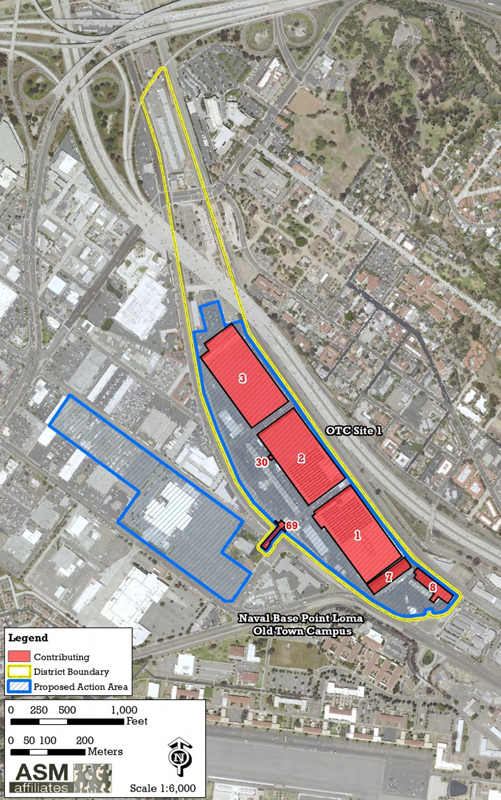|
Navy Project Would Demolish Consolidated Aircraft Historic District
January/February 2022
 Aerial view map of the Consolidated Aircraft Plant 2 Historic District, San Diego. Courtesy Navy OTC Revitalization Draft EIS, Appendix H: Cultural Resources Technical Report, p. H-39. |
The Navy's Old Town Campus Revitalization project at NAVWAR has the distinction of being the only newly added site to SOHO's 2021 Most Endangered List. This ill-advised, gargantuan project proposes to build a dense wall of high-rise buildings at 4301 Pacific Highway (known as OTC Site One) and the complete demolition of the Consolidated Aircraft Plant 2 Historic District. Previously known as Convair, this plant was once a massive manufacturing aircraft production complex that employed thousands of San Diegans during World War II and the Cold War. It is eligible for the National Register of Historical Places under three criteria.
Founded by Reuben H. Fleet and completed in October 1941, less than six weeks before the U.S. entered WWII, the plant focused on the design and production of planes, orbiting spacecraft, and missiles. Today, the district encompasses seven contributing historical resources, all at OTC Site One: administration buildings, warehouse facilities, a paint shop, and the pedestrian bridge (see map). The loss of these important resources would be devastating to the understanding and representation of San Diego's national role in the war and the aerospace industry.
This plant is directly associated with WWII aircraft manufacturing and home-front labor, making it highly significant under Criterion A. Workers here, including countless women, designed and constructed B-24 heavy bombers and PBY Catalinas that were crucial to the Allied Forces' success. During the Cold War, the Consolidated Aircraft Plant 2 Historic District saw the development and production of many significant types of aircraft, orbiters, and missiles. These include F-102 and F-106 interceptor aircraft, major components of spacecraft sent into orbit, such as Enterprise and Challenger, Ground Launch Cruise Missiles, and much more.
This district is also important for an association with Reuban H. Fleet (under Criterion B), who was the founder of Consolidated Aircraft, once the nation's leading producer of military training planes. Inducted into the International Air and Space Hall of Fame and the National Aviation Hall of Fame, Fleet made highly significant contributions to aerospace technology.
The massive scale of these buildings and their design represent a property type from the Industrial Revolution that focuses on admitting natural light and air, making them significant for architecture under Criterion C. They represent permanent military architecture that functioned collectively as an assembly line of buildings. The district's character-defining features include the immense size of these warehouse facilities, rectangular building forms, expansive interior open space, steel sash windows, corrugated iron exteriors, sawtooth roofs with skylights, and steel trusses between structures.
These seven structures serve as important evidence of San Diego's role in the war effort and aerospace advancement on a worldwide stage. We must advocate for their preservation and not lose this irreplaceable National Register-eligible historic district! To read more about SOHO's broad opposition to this misguided and overbearing project, see HERE.
|
2025
2024
2023
2022
2021
2020
2019
2018
2017
2016
2015
|




